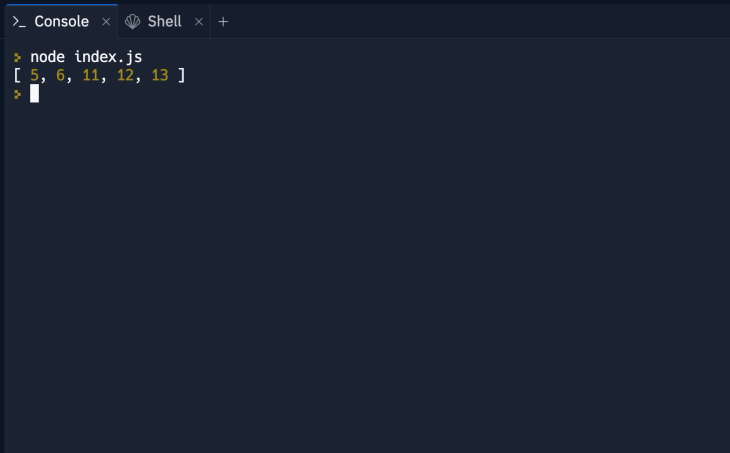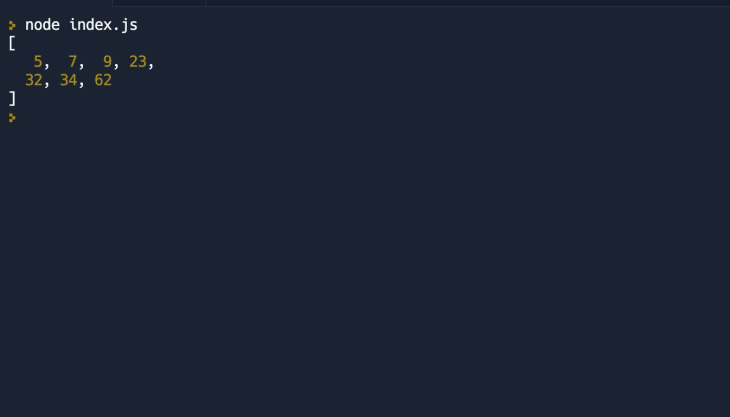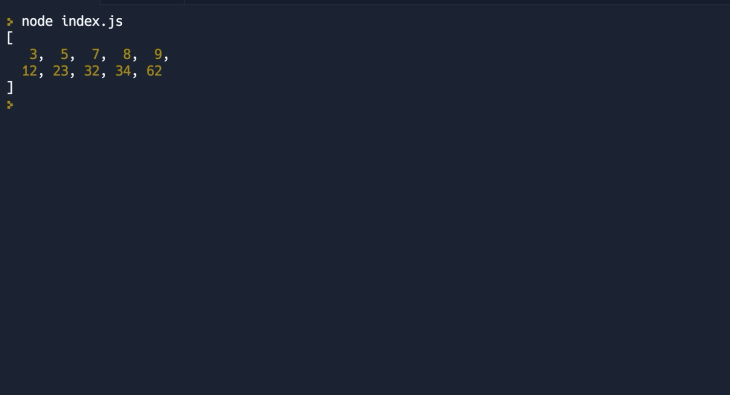
Data sorting has many practical applications in modern applications, such as organizing a list of names, searching for a specific item in a database, or optimizing the performance of web applications.

There are many popular sorting algorithms, each with its advantages and disadvantages. Different data-sorting techniques can affect the speed and efficiency of computations. Inefficient sorting can result in sluggish system performance and negatively impact UX.
It’s crucial to choose the appropriate sorting technique for your needs when working with algorithms and data structures in software development. Your choice of algorithm depends on factors such as the size of the dataset and the level of sorting efficiency you desire.
In this article, we’ll discuss various sorting techniques and how to use them effectively in JavaScript projects. We’ll cover:
By the end of this article, you should have a better understanding of how to choose the right sorting technique for your next project.
The Replay is a weekly newsletter for dev and engineering leaders.
Delivered once a week, it's your curated guide to the most important conversations around frontend dev, emerging AI tools, and the state of modern software.
You can implement popular sorting algorithms with JavaScript. Understanding these algorithms and their practical applications is essential for making informed choices when dealing with different datasets.
Insertion sort is a simple sorting algorithm that repeatedly builds a sorted part of the array while iterating through the unsorted data. Insertion sort algorithms insert each unsorted element into its correct position with the sorted data:
// This function sorts an array using the Insertion Sort algorithm.
function insertionSort(arr) {
// Start iterating from the second element of the array.
for (let i = 1; i < arr.length; i++) {
// 'current' is the element to be inserted in its correct place.
let current = arr[i];
// 'j' will help us traverse backwards from the 'i'th position.
let j = i - 1;
// Keep moving elements of arr[0..i-1] that are greater than 'current'
// one position ahead of their current position.
// The loop continues until we find the right spot for 'current' or reach the beginning of the array.
while (j >= 0 && arr[j] > current) {
arr[j + 1] = arr[j]; // Move the element one position up.
j--; // Move one position back in the array.
}
// Place 'current' in its correct position so that the elements before it are less than 'current'.
arr[j + 1] = current;
}
// Return the sorted array.
return arr;
}
const unsortedArray = [12, 11, 13, 5, 6];
const sortedArray = insertionSort(unsortedArray);
console.log(sortedArray); // This will print the sorted array.
The insertionSort function takes in an array, sorts it, and returns the sorted array. The function uses a for loop to iterate over elements and a while loop for comparison while sorting and inserting the sorted data into the array.
Here are the best-, average-, and worst-case scenarios for using the insertion sort algorithm. These scenarios describe the time complexity of the insertion sort method under different conditions in terms of the amount of computational work and memory needed:
O(n) when the array is nearly sorted; the insertionSort function only needs to make one pass through the arrayO(n^2), where n is the number of elements; the insertionSort function may need to pass through the array multiple timesO(n^2) when the array is sorted in reverse order; the insertionSort function will need to do the maximum amount of work, making multiple passes through the arrayInsertion sort is suitable for small datasets where elements are continuously added to a sorted list. This sorting technique is handy where the input size is small and mostly sorted already — for example, sorting a hand of playing cards:

The quicksort algorithm is a divide-and-conquer sorting algorithm that selects a pivot element and partitions other elements into two sub-arrays according to the size of the pivot:
function quickSort(arr) {
// Base case: If the array has one or no elements, it is already sorted.
if (arr.length <= 1) return arr;
// Choosing the first element in the array as the pivot.
const pivot = arr[0];
// Creating two empty arrays to store elements less than (left) and greater than (right) the pivot.
const left = [];
const right = [];
// Looping through the array, starting from the second element because the first is the pivot.
for (let i = 1; i < arr.length; i++) {
// If the current element is smaller than the pivot, push it to the 'left' array.
if (arr[i] < pivot) left.push(arr[i]);
// If the current element is greater than or equal to the pivot, push it to the 'right' array.
else right.push(arr[i]);
}
// Concatenate the result of recursively sorting the 'left' array, the pivot, and then the 'right' array.
// Spread syntax '...' is used to concatenate arrays.
return [...quickSort(left), pivot, ...quickSort(right)];
}
const unsortedArray = [34, 7, 23, 32, 5, 62, 9];
const sortedArray = quickSort(unsortedArray);
console.log(sortedArray); // This will output: [5, 7, 9, 23, 32, 34, 62]
The quickSort function sorts an array by comparing the elements with the pivot in a for loop before returning the sorted array. The function uses two arrays for the sorting operation.
Here’s the result of calling the function with an array:

You can use quicksort in many ways, from sorting large datasets in databases to implementing sorting functions in programming languages. Similar to what we did before for the insertion sort method, let’s discuss the average and worst-case scenarios for using the quicksort algorithm:
O(n log n) where n is the number of elements; the array is divided into a balanced manner in most of the steps, leading to a highly efficient sorting timeO(n^2) where the pivot element is the smallest or largest element, which leads to unbalanced partitionsQuicksort is widely used due to its average-case efficiency. It’s handy for general-purpose sorting and is often the default sorting algorithm for developers looking to sort data in an application.
Merge sort is another divide-and-conquer sorting algorithm that divides the unsorted list into n sublists. Each list contains one element and repeatedly merges sublists to produce new sorted sublists until only one remains:
// This function performs the merge sort algorithm on an input array.
function mergeSort(arr) {
// If the array has one or fewer elements, it's already sorted, so we return it.
if (arr.length <= 1) return arr;
// Calculate the middle index of the array.
const middle = Math.floor(arr.length / 2);
// Split the array into two halves: left and right.
const left = arr.slice(0, middle);
const right = arr.slice(middle);
// Recursively merge, sort the left and right halves, and return the result.
return merge(mergeSort(left), mergeSort(right));
}
// This function merges two sorted arrays into a single sorted array.
function merge(left, right) {
// Initialize an empty result array and indices for left and right arrays.
let result = [];
let leftIndex = 0;
let rightIndex = 0;
// Compare elements from both arrays and add the smaller element to the result.
while (leftIndex < left.length && rightIndex < right.length) {
if (left[leftIndex] < right[rightIndex]) {
result.push(left[leftIndex]);
leftIndex++;
} else {
result.push(right[rightIndex]);
rightIndex++;
}
}
// Concatenate the remaining elements from both arrays (if any) to the result.
return result.concat(left.slice(leftIndex), right.slice(rightIndex));
}
const unsortedArray = [34, 7, 23, 32, 5, 62, 9, 12, 3, 8];
const sortedArray = mergeSort(unsortedArray);
console.log(sortedArray); // This will print the sorted array to the console.
The mergeSort function checks if the input array arr has one or fewer elements before starting the sorting operation. If not, it calculates the middle of the array and then divides it into two halves — left and right — before recursively sorting each half with the same mergeSort function.
On sorting the halves, the merge function merges them into one array after comparing elements from each array and appending them to the end of the result, ensuring a complete, sorted array.
Here’s the result of calling the function on an array with elements:

Merge sort has consistent O(n log n) time complexity in all cases, making it efficient for both small and large datasets. It’s also a stable sorting technique that preserves the order of equal elements.
Merge sort is commonly used in external sorting algorithms for large data sets that do not fit entirely in memory. It’s also used as a standard sorting algorithm due to its predictable performance.
Many other sorting algorithms exist, including heapsort, bubble sort, and more. Here’s a brief introduction to some of them:
O(n^2) time complexity, but it can be helpful for small datasetsEach sorting algorithm has strengths and weaknesses, making them suitable for specific scenarios. The sorting algorithm choice depends on data size, desired time complexity, and specific use case requirements.
Sorting algorithms have their place in both frontend and backend systems. Understanding the distinctions between frontend and backend sorting is essential for creating well-rounded applications.
Sorting on the front end is a common operation, especially when dealing with datasets you must display to users in a specific order. The primary functions of sorting in frontend applications include:
More often than not, JavaScript is the preferred way to implement frontend sorting, as it allows for real-time sorting without needing page reloads.
The efficiency of traditional sorting algorithms can vary based on the type and quantity of data you need to sort. In frontend apps, the time it takes to sort data can directly impact rendering times, overall application responsiveness, and user experience.
For example, let’s see what happens when using the bubbleSort function on a list with thousands of items to be rendered in a React component:
function bubbleSort(arr) {
let n = arr.length;
for (let i = 0; i < n-1; i++)
for (let j = 0; j < n-i-1; j++)
if (arr[j] > arr[j+1]) {
let temp = arr[j];
arr[j] = arr[j+1];
arr[j+1] = temp;
}
return arr;
}
function RenderList(props) {
let sortedList = bubbleSort(props.data);
return (
<ul>
{sortedList.map(item => <li key={item.id}>{item.value}</li>)}
</ul>
);
}
After re-rendering components, the program re-sorts the data, which may lead to a noticeable lag for larger datasets.
With real-time data visualization, data often comes in rapidly and needs to be incorporated into the visual representation just as quickly. Efficient sorting is crucial here, as slow sorting can introduce noticeable lag.
For instance, if you’re visualizing stock prices in real-time and new data comes in every second, you’d need to efficiently insert the new data point into the existing sorted dataset without re-sorting the entire dataset.
While the performance of sorting algorithms may not differ across frameworks, the way different frameworks detect data-changing models and trigger re-renders can vary.
For instance, React uses a virtual DOM to limit the number of actual DOM mutations. However, it can still be a bottleneck if the dataset changes frequently or the sorting operation is expensive.
Vue, on the other hand, uses a reactive data model. This means that sorting operations that change the dataset immediately trigger a re-render of the affected component.
Meanwhile, Angular uses change detection to determine when views should be updated. The strategy chosen — Default or OnPush — may influence how sorting operations impact rendering performance.
In backend systems, sorting is crucial for data processing, analytics, and server-side storage. Sorting impacts the order of result presentation to users. Some of its critical applications are:
Most of the sorting operations on your backend will be on your database. You’d typically implement sorting in your backend system with your preferred server-side programming language, such as Go, JavaScript, Python, or C++.
Data sorting looks slightly different for SQL databases and NoSQL databases. Here are some critical aspects of sorting in SQL databases:
ORDER BY clause: SQL databases provide the ORDER BY clause, which allows you to sort query results based on one or more columns. You can sort based on ascending or descending orderOn the other hand, sorting in NoSQL databases involves the following:
To optimize backend database queries with sorting, you must consider various factors, including the volume of data, query complexity, and the specific database management system you use.
You can use techniques like indexing, batch processing, pagination, asynchronous sorting, and caching for faster operations.
As we already know, choosing the right sorting technique depends on several factors, including the data quantity, nature, stability requirements, and memory and space constraints. Let’s discuss some of these in more detail now.
A primary consideration when choosing a sorting algorithm is the size of the dataset. Different algorithms have varying performance characteristics that make them suitable for specific data sizes.
For small data sets, the choice of sorting algorithm may not significantly impact performance. Simple algorithms like insertion sort or selection sort can be efficient enough and easy to implement.
When dealing with medium-sized data sets, algorithms like merge sort, quicksort, or heap sort may be more efficient. These algorithms have better average and worst-case time complexity and can handle larger data sets without performance bottlenecks.
Considering time complexity and memory usage becomes crucial for large data sets. Quicksort and heap sort are often preferred due to their relatively low memory requirements and efficient average-case performance.
The nature of the data you are sorting can significantly impact the choice of sorting algorithm. Different algorithms exhibit different behaviors with specific data characteristics.
If the data set contains numerous duplicate values, the efficiency of sorting algorithms may vary. Quicksort struggles in these situations, often resulting in uneven partitions. On the other hand, merge sort and heap sort are more adept at handling duplicates, preserving the relative order of identical elements.
However, suppose you’re handling partially sorted data. In that case, you can use algorithms like insertion sort to achieve a linear time complexity, since quicksort and heap sort might face their most challenging scenarios with sorted or reverse-sorted data.
You can classify sorting algorithms into two categories based on memory usage: in- and out-of-place sorting.
In-place sorting algorithms like quicksort, bubble sort, and insertion sort require only constant memory for temporary variables, regardless of the data set size. These algorithms are suitable for limited memory.
On the other hand, out-of-place sorting algorithms require additional memory space proportional to the size of the data. Merge sort is a classic example of an out-of-place sorting algorithm. While they may use more memory, out-of-place algorithms are often more stable and can be more straightforward.
Choosing between in-place and out-of-place sorting depends on the available memory and your application’s specific requirements. If memory is not a concern, you can opt for an out-of-place algorithm that may offer better stability and ease of implementation.
Let’s quickly summarize what we’ve discussed so far in the comparison table below:
| Algorithm | Memory usage | Best for… | Average case time complexity | Worst case time complexity | Space complexity | Most stable complexity |
|---|---|---|---|---|---|---|
| Insertion sort | In-place sorting; requires constant memory for temporary variables | Small data sets | Partially sorted data | Limited memory | O(n^2) | O(n^2) |
| Selection sort | In-place sorting; requires constant memory for temporary variables | Small data sets | – | O(n^2) | O(n^2) | O(1) |
| Merge sort | Out-of-place sorting; requires memory space proportional to data size | Medium-sized data sets | Handling duplicates | O(n log n) | O(n log n) | O(n) |
| Quicksort | In-place sorting; requires constant memory for temporary variables | Medium to large data sets | Handling duplicates | O(n log n) | O(n^2) | O(log n) |
| Heapsort | In-place sorting; requires constant memory for temporary variables | Medium to large data sets | – | O(n log n) | O(n log n) | O(1) |
| Bubble sort | In-place sorting; requires constant memory for temporary variables | – | – | O(n^2) | O(n^2) | O(1) |
| Radix sort | Out-of-place sorting; requires memory space proportional to data size | Large data sets | Integers | O(kn) | O(kn) | O(k) |
You can use this table to help guide your decision regarding which sorting algorithm to implement in your next project.
This article discussed popular sorting algorithms and how to implement them with JavaScript. You also learned about the importance of and differences between implementing sorting in your frontend and backend applications.
Choosing the suitable sorting algorithm for a specific task depends on various factors, including the size of the dataset, the desired level of sorting efficiency, and the stability requirements of the algorithm. I hope this guide will be helpful as you determine which technique is best for your needs.
Debugging code is always a tedious task. But the more you understand your errors, the easier it is to fix them.
LogRocket allows you to understand these errors in new and unique ways. Our frontend monitoring solution tracks user engagement with your JavaScript frontends to give you the ability to see exactly what the user did that led to an error.

LogRocket records console logs, page load times, stack traces, slow network requests/responses with headers + bodies, browser metadata, and custom logs. Understanding the impact of your JavaScript code will never be easier!

Container queries let components respond to their own layout context instead of the viewport. This article explores how they work and where they fit alongside media queries.

React Server Components vs Islands Architecture: Learn how each reduces client JavaScript, impacts hydration and interactivity, and which trade-offs matter for production performance.

Large hosted LLMs aren’t always an option. Learn how to build agentic AI with small, local models that preserve privacy and scale.

What storylines defined 2025 in frontend development? We power rank them all, from AI advancements to supply chain attacks and framework breakthroughs.
Hey there, want to help make our blog better?
Join LogRocket’s Content Advisory Board. You’ll help inform the type of content we create and get access to exclusive meetups, social accreditation, and swag.
Sign up now
One Reply to "Choosing the best JavaScript sorting algorithm for your project"
Thank you for such great article.